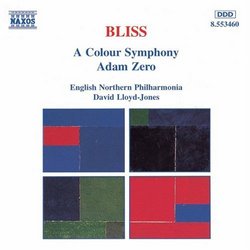| All Artists: Arthur Bliss, David Lloyd-Jones, English Northern Philharmonia Title: Bliss: A Colour Symphony; Adam Zero Members Wishing: 0 Total Copies: 0 Label: Naxos Original Release Date: 1/1/1996 Re-Release Date: 7/9/1996 Genre: Classical Styles: Ballets & Dances, Ballets, Historical Periods, Modern, 20th, & 21st Century, Symphonies Number of Discs: 1 SwapaCD Credits: 1 UPC: 730099446020 |
Search - Arthur Bliss, David Lloyd-Jones, English Northern Philharmonia :: Bliss: A Colour Symphony; Adam Zero
 | Arthur Bliss, David Lloyd-Jones, English Northern Philharmonia Bliss: A Colour Symphony; Adam Zero Genre: Classical
|
Larger Image |
CD DetailsSimilarly Requested CDs
|
CD ReviewsBliss orchestral colour K. Farrington | Missegre, France | 03/09/2000 (5 out of 5 stars) "It is always as difficult thing to attempt to encapsulate music on the form of words and worse still to generalise about a composer. However, to my mind Arthur Bliss worked within three styles within which he moved around throughout his long career. The first style, around which this CD gravitates, is a lyrical successor to Elgar, a contemporary of John Ireland. The second style is a balletic, twisting, muscular tapestry in which he can depict the squalor of a tenement as in 'Miracle in the Gorbals' or portray the cycle of life and death as in 'Adam Zero' here. The third style is a synthesis of the two which can lead into an apocalyptic struggle, culminating in a dark victory with full orchestra as in the 'Things to Come'. The flowing melodic lines, the clean and fresh orchestration that has a spark of originality make his first style very approachable. The 'Color Symphony'(1922) is an early work based on heraldric use of color rather than a broader artistic sense, giving Bliss license to explore his first style to an extent as he would in no other subsequent work. The first movement 'Purple' uses a 'nobilmente' style redolent of Elgar but with an unearthly, ghostly undertone. The scherzo 'Red', is reminiscent of the equivalent movement in Vaughan Williams' 'A London Symphony' with its delightful use of dancing rhythms and tone color. Bliss does not use folk idioms like VW and yet maintains an English flavour throughout. Adam Zero has music of the first two styles, setting out the journey of Man as he progresses through the stages of life's way in an almost pagan depiction of the annual and human life cycle. The scoring, the music throughout is totally brilliant and it is deplorable that this wok is not performed more often. Bliss uses the then contemporary music to show a night club and the death of Adam is totally lacking in pathos and we have the distance of a dispassionate observer throughout. This a story of nature, beyond good and evil and Bliss keeps his musical arguments legitimate. He was a truthful artist who never pandered to an easy and more populist style which might have won him more converts. I believe that his honesty will pay off in the fullness of time. Superb playing by the English Northern Philharmonia and full marks to Naxos for having the idea of providing us with the more neglected works in the repertoir." Delightful David A. Kemp | Plano, TX USA | 07/07/2003 (5 out of 5 stars) "This is an outstanding entry in the rich, rewarding Naxos catalog of twentieth-century British music. It has been highly praised, receiving a number of favorable reviews. Personally I find its music delightful and exceptionally attractive. Sir Arthur Bliss (1891-1975; he succeeded Bax as Master of the Queen's Music in 1953) conceded that he found it easier to write "dramatic" or "program" music than "pure" or "absolute" music; in other words, he preferred to write music that was about something. A Colour Symphony (1922), his first major orchestral work, was written at the instigation of Elgar. Bliss conceived the idea of a symphony based on colors: "I saw the possibility of so characterizing the four movements of a symphony, that each should express a colour as I personally perceived it." The four movements are: (1) Purple (Andante maestoso), described by Bliss as "the Colour of Amethysts, Pageantry, Royalty and Death"; (2) Red (Allegro vivace), "the Colour of Rubies, Wine, Revelry, Furnaces, Courage and Magic"; (3) Blue (Gently flowing), "the Colour of Sapphires, Deep Water, Skies, Loyalty and Melancholy"; and (4) Green (Moderato), "the Colour of Emeralds, Hope, Youth, Joy, Spring and Victory." Elgar found the symphony too modern for his Edwardian taste, but it doesn't sound particularly modern to our ears, and in fact seems to me strongly reminiscent of Elgar. It has been described as young man's music.Adam Zero (1946) was Bliss's third ballet, written for the Sadlers Wells company and a product of his maturity. The story is of a company creating a ballet, and the creation of the ballet is seen as an allegory for the span of human life. Adam Zero is in one scene, with 21 brief musical numbers, lively and multi-faceted. Bliss considered it his most varied and exciting ballet score.Bliss has been described (Oxford Dictionary of Music) as the composer of "works in a bold, post-Elgarian style, vigorous and rich in texture but lacking the inner poetry of his model." He may not be of the stature of Elgar, but his best music deserves hearing and commands attention. These are two of his major works, and I find all the music on this CD pleasing, appealing, accessible, mercurial, colorful and imaginative, full of interest. Its idiom is one of conservative, tonal modernism. None of it is aggressively modern, atonal, dissonant, discordant. The performances (in Leeds Town Hall, 1995) leave nothing to be desired; Lloyd-Jones has shown himself to be a distinguished exponent of twentieth-century British music, and the English Northern Philharmonia (which he founded and built) plays with polish, precision, and richness of tone. Two more pluses: the sound is superb, and the disc is budget-priced. I warmly recommend this CD to any lover of orchestral music." Los Colores de Sir Arthur Bliss Francisco J. Mu�oz | Santa Cruz, Bolivia | 03/09/2001 (5 out of 5 stars) "Sir Arthur Bliss uno de los más destacados compositores británicos de su generación en la actualidad se encuentra muy olvidado en forma injusta. Pues es un compositor de gran talento y buen gusto, seguidor de la escuela de su ilustre predecesor Sir Edward Elgar. "A Colour Symphony" es en cuatro movimientos, donde cada uno representa un color: Púrpura, Rojo, Azul y Verde, donde Bliss expresa sus impresiones de las connotaciones personales que cada uno de estos colores representan para él, en el folleto del disco, están los significados para Bliss de cada color. Musicalmente hablando la obra es de indiscutible belleza, es una partitura para gran orquesta, donde las melodías se mezclan en remembranzas de la vieja y rica tradición Inglesa con ideas modernistas de principios del Siglo XX. El Ballet Adam Zero es agradable de principio a fin, donde Bliss utiliza en forma muy inteligente sus sólidos conocimientos de orquetación.La dirección de David Lloyd-Jones, es muy limpia y activa, respaldado por una muy buena orquesta. Fuertemente recomendado."
|

 Track Listings (21) - Disc #1
Track Listings (21) - Disc #1








